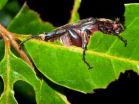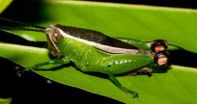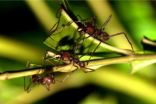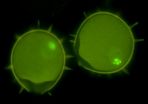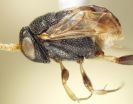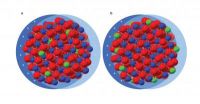(Press-News.org) Observations of insects and their feeding marks on leaves in modern forests confirm indications from fossil leaf deposits that the diversity of chewing damage relates directly to diversity of the insect population that created it, according to an international team of researchers.
"The direct link between richness of leaf-chewing insects and their feeding damage across host plants in two tropical forests validates the underlying assumptions of many paleobiological studies that rely on damage-type richness as a means to infer changes in relative herbivore richness through time," the researchers report in today's (May 2) issue of a.
Studies of leaf chewing include observation of the leaves, but rarely include all the insects that actually made the marks. Mónica R. Carvalho, graduate student, Cornell University and Peter Wilf, professor of geosciences, Penn State, and colleagues looked at leaf predation in two tropical forests in Panama to test for a relationship between the richness of leaf-chewing insects and the leaf damage that the same insects induce.
Using Smithsonian Tropical Research Institute canopy-access cranes and working in the dark at almost 200 feet high in the treetops at new moon during two summers the researchers collected a total of 276 adult and immature leaf-chewing insects of 156 species. While the largest category of insect was beetles, leaf chewers among grasshoppers, stick insects and caterpillars, as well as a few ants, were also collected.
The team also collected fresh leaves of the insects' host plants and placed the insects in feeding experiment bags with these leaves. They allowed adult insects to feed for two to three days and immature stages to feed until full maturity when possible. The researchers then classified the damage to the leaves into categories, in the same way they catalog fossil leaf- chewing damage.
"This is the first attempt to compare leaf-chewing damage inflicted by many kinds of living insects on many kinds of plants throughout a large forest area, both to the culprit insects and to the leaf damage we see in the fossil record," said Carvalho. "We mounted 276 of the insects with their damaged leaves and deposited them in the STRI Insect Collection."
This collection is the only known vouchered collection of diverse, identified insects and their feeding damage on leaves of identified plant hosts.
The number of collected insect species correlated strongly with the number of damage types recorded in canopy leaves of 24 tree and liana species observed in the feeding experiments. This suggests that the number of types of damage seen in the fossil record is also related to the actual diversity of damage-making insects.
The researchers also compared the modern leaf data to fossil data from Colombia, Argentina, the Great Plains and the Rocky Mountains. They found that the distribution of chewing marks was the same across both modern and ancient settings, showing a striking consistency in how insects have divided up their leaf resources since at least the end of the age of dinosaurs.
"In the fossil record we frequently find a decrease in damage-type richness during cooling events and after extinctions and an increase in damage-type richness during warming events and post-extinction recovery," said Wilf. "Usually, insect body-fossils from these critical time intervals are absent or very rare, so we rely on the insect-damaged leaves to tell the story. These fossil studies have been considered tremendously important for understanding how ecosystems have responded, and will respond, to climate change and disturbance. We now have direct observational evidence that the fossil data represent changes in actual insect richness and no longer need to infer this through deduction alone."
"This work also unlocks the potential to use insect damage as a new way to assess living insect richness, as in the fossil record, in the context of climate change," said Carvalho. "We used fossils to frame a hypothesis about how the world works, today and through time, and discovered in the living tropical rainforest that the hypothesis is correct. More kinds of chewing marks means more kinds of insects."
INFORMATION:
Other researchers on this project were Héctor Barrios, Programa de Maestría en Entomología, Universidad de Panamá; Donald M. Windsor and Carlos A. Jaramillo, Smithsonian Tropical Research Institute, Panamá; Ellen Currano, assistant professor of geology and environmental earth science, Miami University of Ohio; Conrad C. Labandeira, department of paleobiology, Smithsonian Institution and department of entomology, University of Maryland.
The David and Lucile Packard Foundation and the National Science Foundation supported this research.
Leaf chewing links insect diversity in modern and ancient forests
2014-05-03
ELSE PRESS RELEASES FROM THIS DATE:
Salk scientists reveal circuitry of fundamental motor circuit
2014-05-02
LA JOLLA—Scientists at the Salk Institute have discovered the developmental source for a key type of neuron that allows animals to walk, a finding that could help pave the way for new therapies for spinal cord injuries or other motor impairments related to disease.
The spinal cord contains a network of neurons that are able to operate largely in an autonomous manner, thus allowing animals to carry out simple rhythmic walking movements with minimal attention—giving us the ability, for example, to walk while talking on the phone. These circuits control properties such as ...
Which came first, bi- or tricellular pollen? New research updates a classic debate
2014-05-02
With the bursting of spring, pollen is in the air. Most of the pollen that is likely tickling your nose and making your eyes water is being dispersed in a sexually immature state consisting of only two cells (a body cell and a reproductive cell) and is not yet fertile. While the majority of angiosperm species disperse their pollen in this early, bicellular, stage of sexual maturity, about 30% of flowering plants disperse their pollen in a more mature fertile stage, consisting of three cells (a body and two sperm cells). And then there are plants that do both.
So which ...
Researchers find unique fore wing folding among Sub-Saharan African Ensign wasps
2014-05-02
Researchers discovered several possibly threatened new species of ensign wasps from Sub-Saharan Africa -- the first known insects to exhibit transverse folding of the fore wing. The scientists made this discovery, in part, using a technique they developed that provides broadly accessible anatomy descriptions.
"Ensign wasps are predators of cockroach eggs, and the transverse folding exhibited by these species may enable them to protect their wings while developing inside the cramped environment of cockroach egg cases," said Andy Deans, associate professor of entomology, ...
Probing dopant distribution
2014-05-02
The icing on the cake for semiconductor nanocrystals that provide a non-damped optoelectronic effect may exist as a layer of tin that segregates near the surface.
One method of altering the electrical properties of a semiconductor is by introducing impurities called dopants. A team led by Delia Milliron, a chemist at Berkeley Lab's Molecular Foundry, a U.S Department of Energy (DOE) national nanoscience center, has demonstrated that equally important as the amount of dopant is how the dopant is distributed on the surface and throughout the material. This opens the door ...
Drinking poses greater risk for advanced liver disease in HIV/hep C patients
2014-05-02
PHILADELPHIA—Consumption of alcohol has long been associated with an increased risk of advanced liver fibrosis, but a new study published online in Clinical Infectious Diseases from researchers at Penn Medicine and other institutions shows that association is drastically heightened in people co-infected with both HIV and chronic hepatitis C virus (HCV) infection. Even light ("nonhazardous") drinking—which typically poses a relatively low risk for uninfected persons—was linked to an increased risk of liver fibrosis in the co-infected group.
Reasons for this are not fully ...
Space Station research shows that hardy little space travelers could colonize Mars
2014-05-02
In the movies, humans often fear invaders from Mars. These days, scientists are more concerned about invaders to Mars, in the form of micro-organisms from Earth. Three recent scientific papers examined the risks of interplanetary exchange of organisms using research from the International Space Station. All three, Survival of Rock-Colonizing Organisms After 1.5 Years in Outer Space, Resistance of Bacterial Endospores to Outer Space for Planetary Protection Purposes and Survival of Bacillus pumilus Spores for a Prolonged Period of Time in Real Space Conditions, have appeared ...
Story tips from the Department of Energy's Oak Ridge National Laboratory, May 2014
2014-05-02
To arrange for an interview with a researcher, please contact the Communications staff member identified at the end of each tip. For more information on ORNL and its research and development activities, please refer to one of our media contacts. If you have a general media-related question or comment, you can send it to news@ornl.gov.
DIESELS – Reducing soot . . .
Nine U.S. diesel engine manufacturers and Oak Ridge National Laboratory are using their collective horsepower to tackle the perennial industry-wide problem of efficiency-robbing soot in engines. Over time, ...
Vanderbilt study explores genetics behind Alzheimer's resiliency
2014-05-02
Autopsies have revealed that some individuals develop the cellular changes indicative of Alzheimer's disease without ever showing clinical symptoms in their lifetime.
Vanderbilt University Medical Center memory researchers have discovered a potential genetic variant in these asymptomatic individuals that may make brains more resilient against Alzheimer's.
"Most Alzheimer's research is searching for genes that predict the disease, but we're taking a different approach. We're looking for genes that predict who among those with Alzheimer's pathology will actually show ...
Researchers find way to decrease chemoresistance in ovarian cancer
2014-05-02
ATLANTA--Inhibiting enzymes that cause changes in gene expression could decrease chemotherapy resistance in ovarian cancer patients, researchers at Georgia State University and the University of Georgia say.
Dr. Susanna Greer, associate professor of biology, and research partners at the University of Georgia have identified two enzymes that suppress proteins that are important for regulating cell survival and chemoresistance in ovarian cancer. Their findings are published in the journal, PLOS ONE.
Ovarian cancer is one of the deadliest gynecological cancers, with a ...
A transcription factor called SLUG helps determines type of breast cancer
2014-05-02
Findings and Significance: During breast-tissue development, a transcription factor called SLUG plays a role in regulating stem cell function and determines whether breast cells will mature into luminal or basal cells.
Studying factors, such as SLUG, that regulate stem-cell activity and breast-cell identity are important for understanding how breast tumors arise and develop into different subtypes. Ultimately, this knowledge may help the development of novel therapies targeted to specific breast-tumor subtypes.
Background: Stem cells are immature cells that can differentiate, ...
